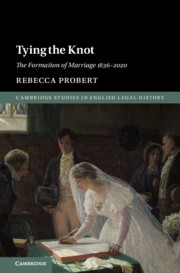Book contents
- Tying the Knot
- Cambridge Studies in English Legal History
- Tying the Knot
- Copyright page
- Dedication
- Contents
- Preface and Acknowledgements
- Abbreviations
- 1 Introduction
- 2 Conception, Design, and Implementation, 1819–1837
- 3 Reactions to the Act, 1837–1854
- 4 Amendments Enacted and Reform Deferred, 1855–1872
- 5 Differences, Divisions, and Dispensing with the Registrar, 1873–1899
- 6 Competing Conceptions of Marriage, 1900–1919
- 7 Consolidating Complexity, 1920–1949
- 8 Convergence? 1950–1993
- 9 The Rise of the Wedding, 1994–2020
- 10 The Legacy of the Past and Lessons for the Future
- Index
9 - The Rise of the Wedding, 1994–2020
Published online by Cambridge University Press: 10 September 2021
- Tying the Knot
- Cambridge Studies in English Legal History
- Tying the Knot
- Copyright page
- Dedication
- Contents
- Preface and Acknowledgements
- Abbreviations
- 1 Introduction
- 2 Conception, Design, and Implementation, 1819–1837
- 3 Reactions to the Act, 1837–1854
- 4 Amendments Enacted and Reform Deferred, 1855–1872
- 5 Differences, Divisions, and Dispensing with the Registrar, 1873–1899
- 6 Competing Conceptions of Marriage, 1900–1919
- 7 Consolidating Complexity, 1920–1949
- 8 Convergence? 1950–1993
- 9 The Rise of the Wedding, 1994–2020
- 10 The Legacy of the Past and Lessons for the Future
- Index
Summary
The Marriage Act 1994 introduced the possibility of marrying on ‘approved premises’. Within a decade of it coming into force, such weddings accounted for half of all civil weddings, and by 2017 almost 70 per cent of all weddings were taking place in such venues. There was a corresponding decline in weddings in Anglican churches and register offices. The fact that couples were increasingly choosing a civil wedding did not, however, indicate that they were rejecting religion: the period also saw the rise of ‘celebratory ceremonies’ held separately from the legal wedding where there were particular obstacles to couples marrying in accordance with their beliefs or wishes. Some couples, meanwhile, married according to religious rites alone, sometimes unaware that such ceremonies had no standing in law. The courts struggled with the question of how such ceremonies should be classified, while official concerns focused in particular on Muslim marriage practices. Finally, in 2020, the restrictions imposed by COVID-19 exposed many of the problems with the current law and brought out the distinction between the celebratory and legal aspects of getting married.
Keywords
- Type
- Chapter
- Information
- Tying the KnotThe Formation of Marriage 1836–2020, pp. 228 - 260Publisher: Cambridge University PressPrint publication year: 2021



